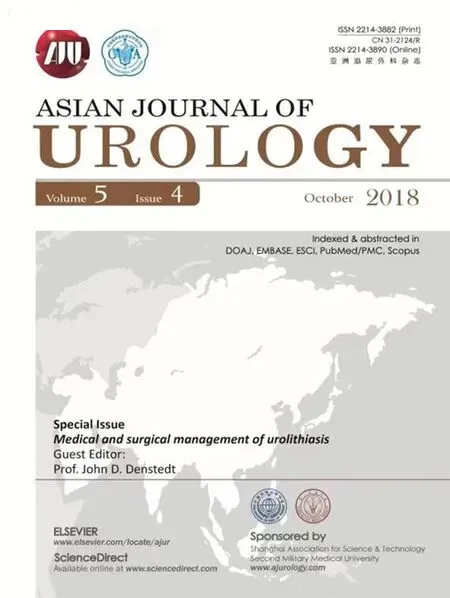Medical and surgical management of urolithiasis
It has been a privilege to have the opportunity to serve as guest editor for this special issue of the Asian Journal of Urology(AJU)on the topic of urolithiasis.Similarly it has been an honor to serve on the editorial board of AJU since its inception and to see the positive evolution of this relatively new urology journal under the leadership of Professor Yinghao Sun.
The surgical management of renal and ureteral stones was forever changed 40 years ago with the near simultaneous introduction of shock wave lithotripsy,percutaneous approaches for stone removal and ureteroscopic techniques.Open surgery for stone removal has effectively disappeared in developed countries.In those countries where it continues to be utilized,the open approach is in significant decline.The relative role of the three minimally invasive approaches remains dynamic however and the surgical techniques continue to evolve driven by the innovative curiosity of urologic surgeons and the parallel refinement in technologies and instrumentation for approaching stone disease.Having had the opportunity to visit,teach and operate in numerous Asian countries on dozens of occasions over the last decade,my observation is that many of the most important and innovative approaches in stone treatment are emanating from Asian centers.
The incidence of urolithiasis is increasing throughout the world and has been documented to be 10%or more of the entire human population in those countries with reliable population databases.Thus the assessment and treatment of patients with stones represents a significant proportion of daily urologic practice and a substantial economic burden on health care systemsglobally.In thisissue ofthe journalKunjie Wang and his colleagues[1]from West China Hospital in Chengdu,China explore the epidemiology of urolithiasis in Asia including the multifactorial nature of the disorder and recent trends in stone occurrence.Similarly Dean G.Assimos and colleagues[2]from the University of Alabama in Birmingham,USA address the role of metabolic syndrome as an underlying cause of many cases of stone disease in Western countries and increasingly so in developing countries.Jennifer Bjazevic and Hassan Razvi[3]from Western University,London,Canada discuss the complex diagnostic and treatment algorithms forpediatric patients with stones and during pregnancy.
While much attention by urologists continues to be focused on surgical therapies,the importance of investigation for underlying metabolic causes of recurrent stones and dietary or pharmacologic intervention for stone prophylaxis is a fundamental part of overall patient care.Dr.Preminger Glenn M.and associates[4]from Duke University and Margaret S.Pearle and her colleagues[5]from UT Southwestern in Dallas provide practicaland contemporary advice on these important aspects of urolithiasis management.
In many countries throughout the world shock wave lithotripsy had been documented to be in decline with a parallel increase in retrograde ureteroscopic approaches to both ureteral and renal stones.Kenneth T.Pace and his colleagues[6]from the University of Toronto provide an excellent update on the current role of shock wave lithotripsy in stone treatment and how to select the best patients for this formoftherapy and to optimize results.Olivier Traxerand his colleagues[7]from Tenon Hospital in Paris have contributed as much as any urologic surgeon worldwide in pushing the limits for ureteroscopic treatment and provide an excellent state-of-the-artupdate on retrograde ureteroscopy forstone management.One of the most common procedures in urologic practice is insertion ofa ureteralstenteither acutely to provide urinary drainage,orconcurrently aspartofdefinitive stone treatment with either shock wave lithotripsy or ureteroscopy.The indications for stent placement continue to evolve and the associated symptoms related to indwelling stents remains a significant burden to patients.Thomas O.Tailly and his colleagues[8]from Ghent Belgium examine the currentrole forthe inclusion ofstentsin stone treatmentand strategies for managing stent associated symptoms.
The techniques for percutaneous renal stone removal remained relatively static for three decades following the initial introduction by the pioneers in endourology.The last several years however have seen a burst of innovations in the technique supported by new endoscope technology and other ancillary equipment.From positioning to exit strategies and all other components of the procedure between start to finish have undergone modification designed to further minimize the invasiveness of the procedure and associated patient morbidity.Mordechai Duvdevani and his colleagues[9]from Hadassah Hospital in Jerusalem provide an excellent update on the new approaches and Guohua Zeng and his colleagues[10]from Guangzhou,China outline the significant trend towards minimizing the size of tract dilation for percutaneous renal procedures.Both articles represent excellent resources for urologists on the current state in performing percutaneous nephrolithotomy.
Finally I would like to thank Shasha Wei and the entire team in the editorial office of the AJU at Changhai Hospital in Shanghai,China.I have had the opportunity to visit the office on two occasions in recent years and this is a small but tremendously dedicated group of talented individuals who are working very hard to advance the AJU.Without their support this special edition would not have come to fruition.I see a great future ahead for the AJU and again it has been a pleasure to work with the team and all of our contributing authors to assemble this excellent issue.
 Asian Journal of Urology2018年4期
Asian Journal of Urology2018年4期
- Asian Journal of Urology的其它文章
- Miniaturised percutaneous nephrolithotomy:Its role in the treatment of urolithiasis and our experience
- Present indications and techniques of percutaneous nephrolithotomy:What the future holds?
- Ureteral stents in urolithiasis
- Retrograde intrarenal surgery:An expanding role in treatment of urolithiasis
- Indications and contraindications for shock wave lithotripsy and how to improve outcomes
- Medical therapy for nephrolithiasis:State of the art
